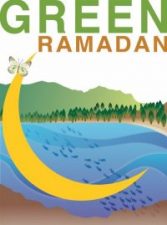
(Snapshot of the WWF coral map of Qatar and UAE coral reefs).
With worrying reports of coral death globally, with global warming to blame, it’s heartening to hear that Arab nations, who are more known for causing global warming, are now working to protect coral reefs. Mapping the reefs to know where to install underwater natural gas pipelines is one of the reasons for their concern:
According to a Qatar newspaper, The Peninsula, Qatar’s Ministry of the Environment and the Environment Agency of Abu Dhabi have jointly installed 16 permanent coral monitoring stations in their marine waters. Four are in Qatar in the regions of Halul, Al Ghabi and Halt Dalma.
Reports say that the first-ever mapping of the coral reef and associated habitats in the Qatari-UAE marine waters showed that the Persian Gulf reefs suffered the strongest disturbances in 1996, 1998 and 2002.
A WWF (World Wildlife Fund) study also found that the corals which grow in eastern Qatar and Abu Dhabi, are in one of the most stressful environment for corals anywhere in the world, mainly due to temperature fluctuations.
In the summer of 1996, temperatures were raised by 2.5 degrees above the seasonal average causing a die off Acroporaspecific species, a fast-growing variety of coral. Then in 1998, another high level of open sea water temperature of 2.5 degrees led to further mortality among all other species, killing corals in some areas, said the report released by WWF.
“It is believed that the Arabian Gulf* coral communities represent a dynamic system that shrinks and expands in response to mortality events triggered by temperature anomalies. During years of temperature extremes, either all corals or just certain species regularly experience significant mortality, or even mass mortality,” the report said.
Not dead yet, the WWF assessment shows that the reefs in these areas are badly in need of protection. The study also revealed that regional development is taking its toll on the reefs.
More on the coral maps developed by the WWF
In 2006, Abu Dhabi, United Arab Emirates – WWF has helped prepare the first map of coral habitats in the southeastern Persian Gulf, highlighting some of the most extensive and biologically important coral reefs around the offshore islands and banks of the United Arab Emirate of Abu Dhabi and Qatar’s harbour.
This large scale habitat map, which is an outcome of the Coral Reef Investigations in Abu Dhabi and Eastern Qatar project, will allow resource managers to assess the quantity and quality of marine resources under their jurisdiction.
Since January 2005, threatened coral habitats of the Persian Gulf have been studied and mapped with a view to developing a comprehensive conservation and management plan for these valuable ecosystems. Alongside, researchers of participating environmental organizations in the UAE and Qatar have received training in both theoretical and practical aspects of project work.
“The project has shown that most Gulf coral reefs are in good health,” said Majid Al Mansouri, Board Member of the Emirates Wildlife Society, an associate organization of WWF in the United Arab Emirates.
“The coral reefs that had suffered severe damage due to past temperature fluctuations should recover and regain their former splendour, provided that no disturbance occurs. With the help of this coral reef map, future protection measures will be made much easier.”
The map has been prepared using Landsat satellite imagery. Although ground-truthing was done at over 1,000 points for accuracy control, it is still a preliminary map that requires fine-tuning and approval from government agencies implementing the project in the UAE and Qatar. This will be taken up in the months ahead, when higher resolution imagery will be used to map areas of special interest in greater detail.
“The production of this coral reef map is a vital contribution to Gulf biodiversity,” said Ahmed Al Sayegh, CEO, Dolphin Energy, a company that is implementing the Dolphin Gas Project designed to supply natural gas from offshore Qatar to the UAE.
Project Coral Reef Investigations in Abu Dhabi and Eastern Qatar is sponsored by Dolphin Energy Ltd., and managed by the Emirates Wildlife Society in association with WWF UAE. The implementation agencies are Environment Agency – Abu Dhabi (EAD) and Supreme Council for Environment and Natural Reserves (SCENR). Technical advisors to the project are National Coral Reefs Institute, Florida, USA.
*(Note: Green Prophet reader Saeed wrote to us to make sure that we emphasize that the Gulf should be called Persian Gulf, not Arabian.)
More on coral reefs in the Middle East:
Monitoring Stations in the United Arab Emirates Show Stressed Out Coral
Coral Reefs Get Sexy To Cope With Global Warming
Will Coral Reefs At Aqaba Be Destroyed By Litter?
Corals Cope With Rising Sea Temperature By Eating High Protein Jellies
Jellyfish Invade Lebanon
Corals Will Melt If CO2 Levels Double
New Research Ship To Paint Red Sea Green



In regards to this article may I respectfully emphasize that the geographical location referred to as the “arabian gulf”, has been known to the entire civilized world for over 2 millennia only as the “Persian Gulf” and any other reference to the contrary is inaccurate.
Interestingly enough, Persian Gulf is actually used as a TAG in this article.
The following are links to the United Nations Geographical maps of the world and the Persian Gulf region. Please take time to view them and notice that the UN refers to this body of water as the Persian Gulf.
http://www.un.org/Depts/Cartographic/map/profile/iran.pdf
http://www.un.org/Depts/dhl/maplib/docs/escwa.pdf
http://www.un.org/Depts/Cartographic/map/profile/qatar.pdf
Most importantly, the United Nations with 22 Arab member states has on two occasions officially declared the name of the waterway to the south of Iran as the Persian Gulf. The first announcement was made through the document UNAD, 311/Qen on March 5, 1971, and the second was UNLA 45.8.2 section C, on August 10, 1984. Persian Gulf is also the recognized name by the British Permanent Committee on Geographical Names (PCGN).
I’ve submitted the above links in order to support this position and clear any confusion as to what to call the Persian Gulf. I also hope this has been only an unfortunate oversight and that it will be corrected immediately. I look forward to your reply and thank you for your attention to this important matter.
Please contact me if you need more information with regards to this topic.
Sincere Regards
Saeed Tasbihsazan
The coral population is in a serious crisis. The starfish is eating them in the Great Barrier Reef and global warming will affect the population too. Happy someone is monitering them.